
DANIEL PAUL | THE TURBOFOLK COLLECTION

Daniel Paul © All rights reserved.
“Sometimes I suffer from the feeling that people have stopped valuing life, displaced death, and even stopped appreciating the things they produce or consume. We abandon wisdom to satisfy our own pride and throw ourselves in solitude instead of mutual joy. At the expense of experiencing the present, we have recourse to the idea of surviving in the future.”
– Daniel Paul

Daniel Paul was born in Prague, former Czechoslovakia, in 1984. Graduated from the Academy of Arts, Architecture, and Design in Prague in 2011. After graduation, he started working in the entertainment industry and devoted himself to free artistic creation.
The formal aspect of his free sculptural work has been changing throughout his life, from abstract works built on products of nature set in public spaces to works created from synthetic materials that have recently been firmly anchored in figural realism. From the content perspective, his current work can be classified as decadent and symbolist, and from the formal point of view, it fits in the categories of realism and pop art.
The way he constructs the figure and plinth refers to the tradition of classical figural sculpture, and his works sometimes resemble heroic dioramas in their form. However, current technologies dominate the methods of processing. The author creates with an eye for detail and an emphasis on the complexity of the whole.
The presence of narrative is essential to his sculptural work. In these stories and genres, Paul often and with pleasure moves between multiple possible interpretations, and his means of expression tend to be controversial. It encourages us to constantly reflect on the boundaries of acceptability between the freedom of artistic expression and social ethos. It is often necessary to read the sculpture from all sides to recognize the conveyed content.
In his portfolio, there are 23 group exhibitions, 14 public art realizations, incl. site-specific projects, as well as many commercial realizations.
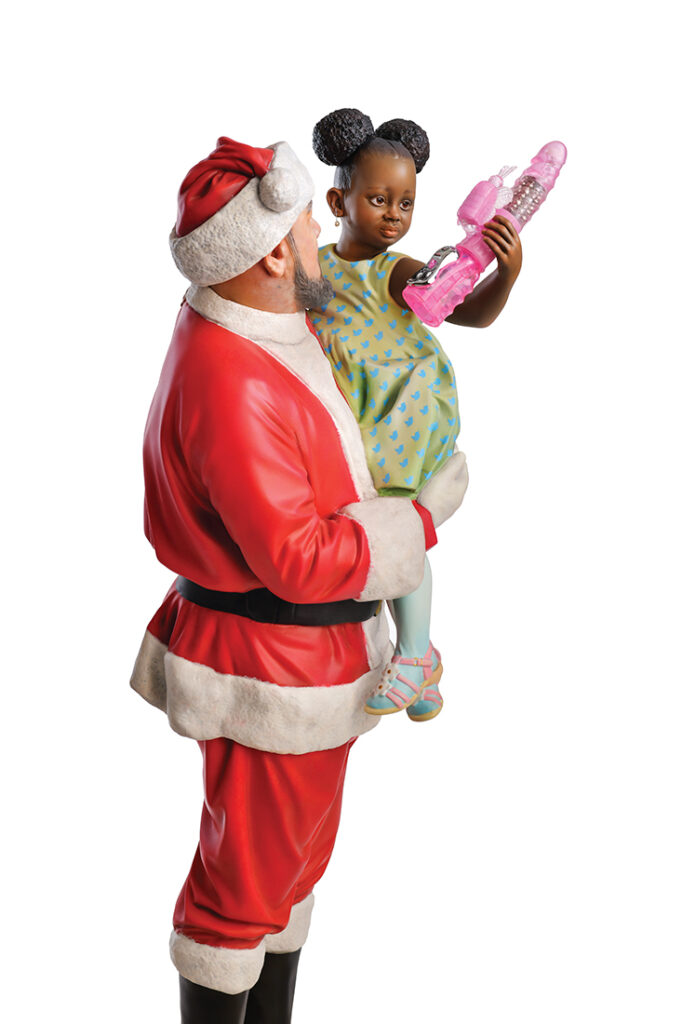
Daniel Paul © All rights reserved.
The Turbofolk Collection
“Just as a sentence acquires meaning only after understanding the relationships between the individual words, the sculpture of the Turbofolk collection reveals its message only after understanding the symbols used in their interrelationships. The sculptures are not an interpretation of specific stories but a leitmotif of a given theme in which several moral positions collide. The messages are multi-layered and require a careful perception of the links between the used elements.”
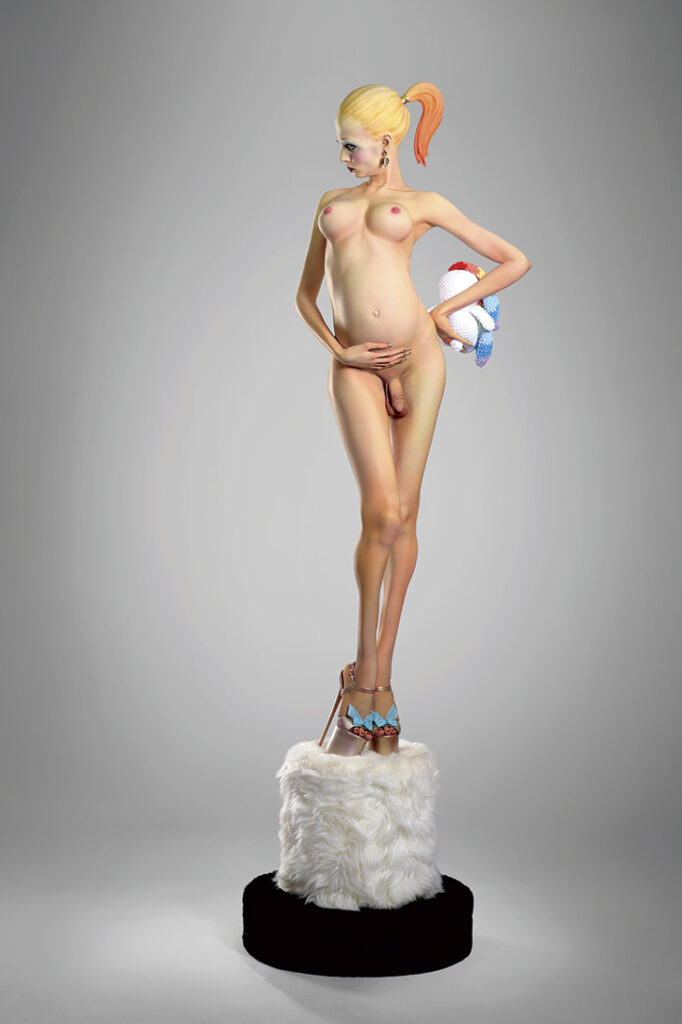
130 x 145 x 50 cm, 2022
Daniel Paul © All rights reserved.
Turbofolk, a figural sculpture collection, was created between 2020-22 during the covid pandemic by Czech sculptor Daniel Paul. The complete set consists of 15 polychrome figures, mostly life-size.
It is a moralistic appeal to reflect on today’s consumer-oriented world. The collection portrays the social problems associated with religion, gender, racism, ecology, and similar topics and opens questions such as the use of power and the freedom of perception. It ironizes people’s connection to fleeting things and draws attention to the fact of separation from profound life experiences.
Turbofolk reflects the current reality, and at the same time, it is also the starting point for creating a new reality – the reality with vision, hope, and a deep beauty that makes us remember where we all are coming from.
Turbofolk also reminds us that how something appears and what it is are two different things. Let’s seek the truth first and start creating from that place.

Daniel Paul © All rights reserved.
Expressing a given topic is always through a man and his corporeality. By using the symbols that are characteristic of each of the described issues, we obtain a person as a typus, a generic representative of
a particular trend. We communicate our attitude and approach to the world through the human body, its attributes, and its positions. Here the soma is the bearer of the message; the péxis, the body illuminated by the soul, seems to be absent.
The final formal perfection and artificiality of the sculpture are intentional. It depicts the body as a product. It needs to be perfect for its purpose; any deviation from this idea is undesirable. Physical flawlessness has become a social norm. However, can such a conception of the body still speak of beauty?
Just as a sentence acquires meaning only after understanding the relationships between the individual words, the sculpture of the Turbofolk collection reveals its message only after understanding the symbols used in their interrelationships. The sculptures are not an interpretation of specific stories but a leitmotif of
a given theme in which several moral positions collide. The messages are multi-layered and require a careful perception of the links between the used elements.
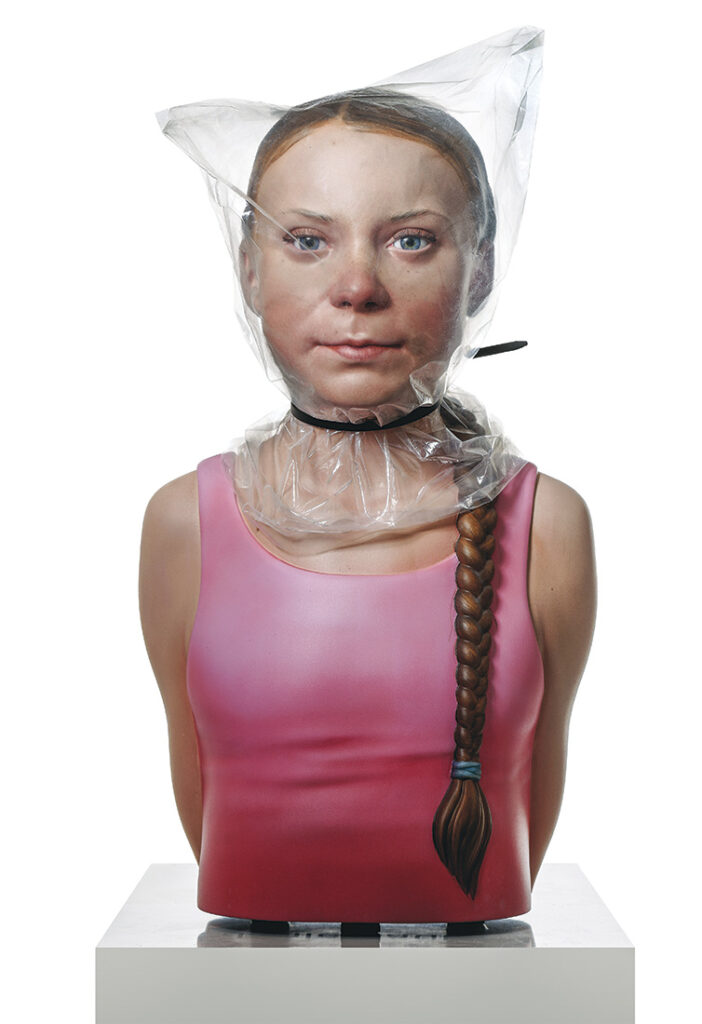
60 x 30 x 20 cm, 2020
Daniel Paul © All rights reserved.
Getting To Know: Daniel Paul
Art Market Magazine: Please share the background of your artistic journey. Did you grow up in a creative environment? What led you into the contemporary art field as a professional artist?
Daniel Paul: As the son of an academic painter, I grew up in a creative environment. From childhood, I was surrounded by catalogs and books about art, and I was also a regular visitor to exhibitions and openings. Even then, I was fascinated by what artists experienced in the creation process and looked forward to my own creative experience. I enjoyed working with different materials the most, and at the same time, I didn’t want to be a painter like my father, so I decided to become a sculptor.
By diving into materials and techniques, I wanted to create pieces that tell stories and touch people.
Still, the path to understanding the meaning and deep significance of art in my life was not an easy one.
It took me many years to understand that art was the most accessible form of expression and an essential need for me.
Through art, I can reflect on myself and the world as I perceive it. In the whirlwind of change, I discovered myself and various social constraints and conventions.
Being a professional artist for me means being connected to galleries, curators, auctions, art institutions, and various financial structures. However, I now finance my free artistic work from other income-generating activities.
On the one hand, this method may partially prevent me from higher productivity and deeper concentration and calmness for free creation; on the other hand, it allows me a higher degree of freedom in topics, form, and creative processes.
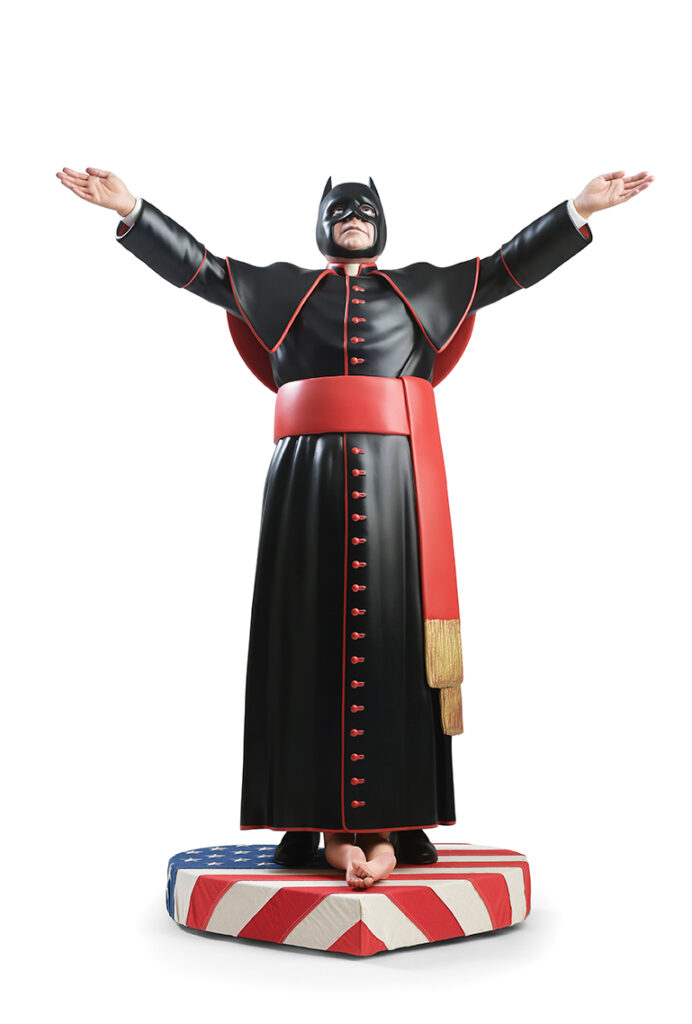
Daniel Paul © All rights reserved.
Art Market Magazine: Where your inspiration comes from? Would you say that your art is influenced by other artists or a specific art field?
Daniel Paul: I see inspiration as a map that allows me to explore different aspects of my interest, from deep topics to advanced technologies. I am open to inspiration from all directions, whether it has a positive or negative form. I am most inspired by social topics related to ethical issues and the changes we face. It concerns themes such as values, prejudices, fears, and the need for certainty of today’s people. Also, the challenge of accepting responsibility for our existence and answering who we are, where we are coming from, and where we are going is very inspiring.
In addition to the above examples, I was inspired by rap music when creating the Turbofolk collection, which also includes the “Superman” sculpture. Just like rap, the Turbofolk collection follows clearly defined formal rules that allow the story to be expressed in a stylized form through symbols and combine them in a unified visual rhythm. At the same time, I was very inspired by the elements of sacred sculptures, where typus, narrative, plinths, attributes, and polychromy are used.
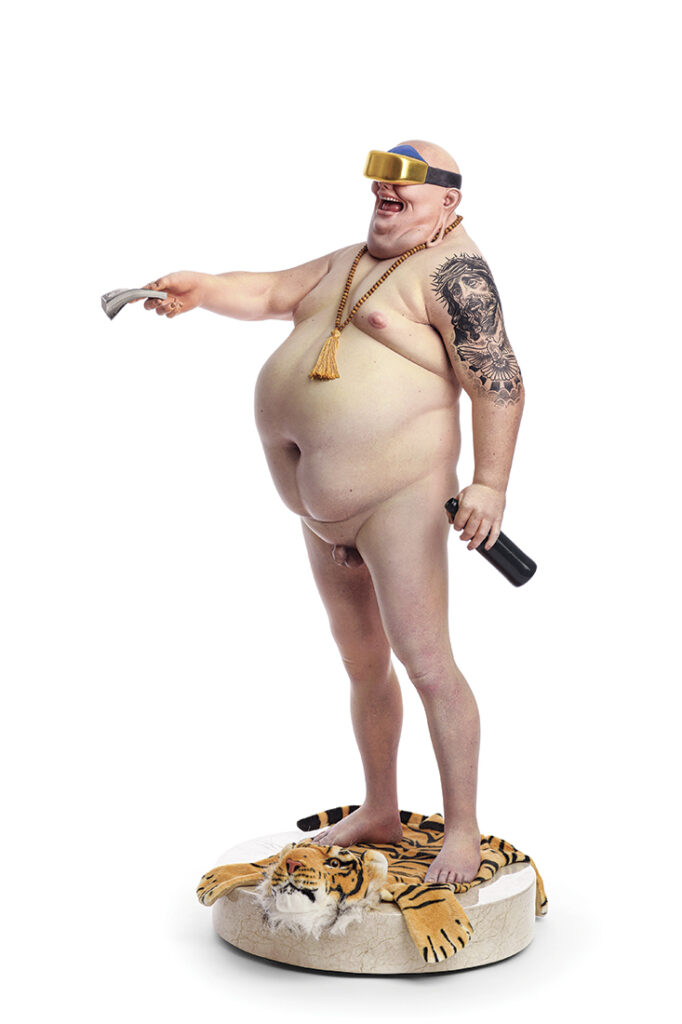
Daniel Paul © All rights reserved.
Art Market Magazine: Let’s talk about your unique technique. Please tell us about the entire work process, from the step of the idea until the final outcome.
Daniel Paul: I consider the choice of subject matter essential in my work because it is crucial for communicating the content – it is the artwork’s message. I need to feel the excitement in the subject matter; I know I’m touching on something essential at that moment. My other approach is already very conceptual – I make careful observations, contemplate, plan, sketch, and design. In the actual implementation, I choose very dynamic processes, yet not demanding time, space, and resources. I always remember doing only the necessary maximum for a particular detail. Anything extra is often very inefficient for the final look of the work and the process itself. It happens that 40% of the effort is enough to achieve an optimal result; the other 60% of the work only affects true art connoisseurs or technology enthusiasts. In fact, with realistic sculptures like mine, it happens that too much fixation on details draws the viewer’s attention to the formal execution of the sculpture rather than its content and message.
My work is a fusion of sculpture, painting, design, and modern technology. Developing this process into a form that suits my approach and current state has taken many years. When I assembled my first 3D printer in 2011, I discovered the enormous potential for my work in its spatial unpretentiousness, its ability to work almost around the clock, and its minimization of waste. The 3D printer allowed me to eliminate these processes, which I found both uncreative and energy-draining. Today, I have a 3D farm. I don’t use 3D scanning; I model my sculptures myself using Zbrush software and other digital tools. It allows me to achieve a high degree of dynamism in model making and create a life-size figurative sculpture in just seven days. I design all the production processes to be able to implement them myself, thus achieving the maximum degree of independence and autonomy in my creative practice.
My process for making a sculpture can be described as a sequence of several essential steps. I start with selecting and defining a theme, which serves as the main inspiration for the whole process. Then comes the modeling. Working with the material, I use different techniques and materials to achieve the desired result.
I carefully consider composition to get the correct arrangement of elements and create a harmonious overall impression. I also concentrate on the structure, which adds expression and depth to the work. I work with different textures to achieve the desired visual effect. The next step is the surface treatment of the work, where the play of light on the sculpture and the color harmony is important to me. I preserve and protect all applied layers of paint with varnish.
The final adjustment of the work and preparation for the presentation is also very important to me personally. This is where curators often come into play, but I prefer to work without direct influence from other people. I want my work to be presented as I imagined and created it. The whole process of making a sculpture is fundamental to me, and I see it as an artistic journey where I am constantly developing and discovering new possibilities. I continuously aim to improve my skills and express myself authentically and personally through my art.
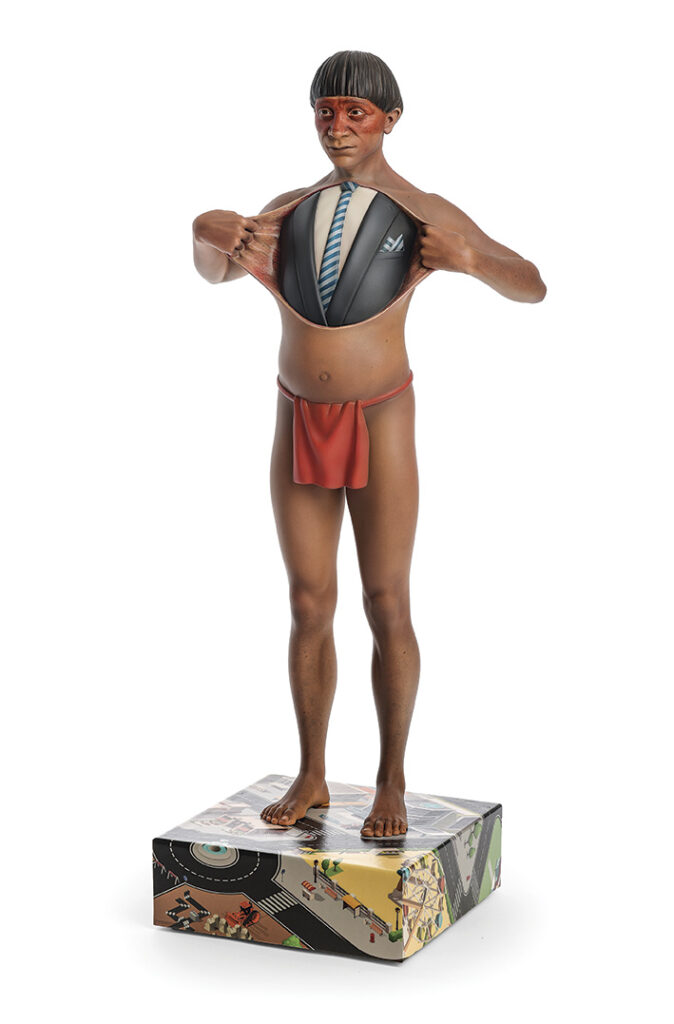
Daniel Paul © All rights reserved.
Art Market Magazine: From your personal journey in the art field, what will be your advice to the young artist looking for a way of development?
Daniel Paul: It very much depends on the young artist’s motivation, talent level, and specific ambitions. But in general, I could advise about this:
Start by opening yourself up to different influences and inspirations – follow other artists, various styles, historical works, and current trends. The art world is rich and diverse. Explore different media, techniques, and genres and combine them.
That will build a wide range of expressive possibilities and can lead you to unexpected results. Don’t be afraid to step out of your comfort zone and try new approaches; look for new ways to express your thoughts and emotions. Experiment! Also, be an active observer of the world around you. Open your senses and take in everything surrounding you, even if it seems unrelated to art.
Be interested in social changes, values, emotional expressions, and prejudices. In this context, you can find the inspiration and message you want to express through your art. Create conceptual works that engage the viewer in interaction.
Share your work with others.
Being part of an artistic community can give you support, feedback, and inspiration. Network with other artists, curators, and professionals, and participate in exhibitions, workshops, and festivals. Be bold and authentic. Feel free to express your own worldview and trust your artistic instinct.
The most compelling works of art often come from personal experience and honest expression by the artist.
Your artistic development is an ongoing process and will take a lifetime. Be patient and open to new challenges as each experience moves you closer to discovering your own artistic voice. In the end, remember that the quality of your art is not determined by market price or the quantity of works sold. The sales rate reflects the quality of the business rather than the artwork itself.
Art Market Magazine: What’s the future hold? Any special exhibitions in the upcoming months?
Daniel Paul: I am currently working on projects that are primarily aimed at the general public as they relate to social issues that I see as important for shaping our common future. One of these projects will have a public presentation in central London on August 23 and another in Berlin in November. I will provide details on my website (danielpaul.cz) and Instagram (@danpaul_sculptor).

